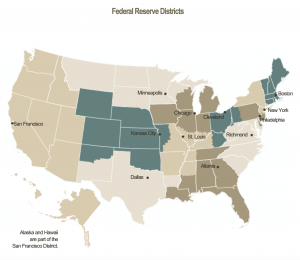Beef prices are projected to continue increasing as U.S. beef production declines with no signs of a cattle herd rebuild. Additionally, cheap beef may soon become further out of reach…
Federal Reserve: Observations on the Ag Economy- February 2022
On Wednesday, the Federal Reserve Board released its February 2022 Beige Book update, a summary of commentary on current economic conditions by Federal Reserve District. The report included several observations pertaining to the U.S. agricultural economy.

* Sixth District- Atlanta– “Agricultural conditions remained mixed. The southern parts of Louisiana and Mississippi experienced moderately dry conditions, while the rest of the District experienced mostly normal conditions. The January production forecast for Florida’s orange crop was down from last year’s production while the grapefruit forecast was unchanged from last year’s production. However, while damages are still being assessed, it was reported that recent cold snaps in Florida are expected to have a material adverse impact on citrus crop yields. The USDA reported year-over-year prices paid to farmers in December and on a month-over-month basis, were up for corn, cotton, rice, soybeans, cattle, broilers, eggs, and milk.”
* Seventh District- Chicago-
Rising prices for agricultural products buoyed expectations for farm income in 2022, though input costs rose as well.
“Corn and soybean prices continued to move up, but prices for energy, fertilizers, and herbicides also rose, and concerns deepened about their availability at planting time given supply chain issues. One contact pointed out a planting decision dilemma: seeds that are more readily available do best when used with herbicides that are in short supply. Supply issues were also delaying some new tractor deliveries, possibly past spring planting. Prices for cattle, hogs, eggs, and milk were up again. Farm finances kept improving, and demand for agricultural loans was lower than a year ago.
#Farm loan volume with "major" or "severe" repayment problems in 7th Federal Reserve District.
— Farm Policy (@FarmPolicy) March 3, 2022
-- @ChicagoFed webinar, "What's Happening in Agriculture," by David Oppedahl, Senior Business Economist. pic.twitter.com/e54h246Q99
“Farmland prices increased more in 2021 than they had in nearly a decade, with continued growth expected in early 2022.”
Index of Seventh District farmland values.
— Farm Policy (@FarmPolicy) March 3, 2022
-- @ChicagoFed webinar, "What's Happening in Agriculture," by David Oppedahl, Senior Business Economist. pic.twitter.com/i2zLaaW0Gi
* Eighth District- St. Louis– “District agriculture conditions have improved modestly since our previous report. The number of acres of winter wheat planted in the District this season have increased 10% over the same period last year. This increase primarily came from Illinois, Kentucky, and Missouri, which saw their acreage rise an average of 20%.
While contacts remain optimistic about 2022, there is continued concern about the increased costs of inputs such as fertilizer, pesticides, and machinery.
“Of particular concern is corn production, which uses significantly more fertilizer than other crops.”
* Ninth District- Minneapolis– “District agricultural conditions improved since the previous report. Farm incomes increased through the end of 2021, according to a survey of agricultural credit conditions. While contacts expressed concern about rising input costs, producers’ finances benefited from strong commodity prices.”
* Tenth District- Kansas City– “Prices of most major commodities in the region increased modestly through early February from already high levels, continuing to support farm incomes. The prices of wheat, cotton and hogs increased modestly from the previous month while corn, soybean and cattle prices increased more sharply. Despite growing concerns about supply chain complications limiting shipping activity, U.S. agricultural exports remained strong and supported demand. Rising input costs have put some downward pressure on profitability for producers, but broad strength in the farm economy continued to support agricultural credit conditions, and farm finances were further bolstered by sharp increases in farmland values.”
* Eleventh District- Dallas– “Drought conditions worsened further, with severe drought expanding in much of the district. Agricultural commodity prices rose across the board over the reporting period, though input costs rose just as much.
Producers fear profits will get squeezed with such high costs; good yields will be important for their financial position this year.
“On the cattle side, prices rose and consumer demand for beef remained solid. An annual inventory report from the U.S. Department of Agriculture showed fewer cattle in Texas; tighter supplies should buoy beef prices this year.”
* Twelfth District- San Francisco– “Conditions in the agriculture and resource-related industries remained largely comparable to the previous reporting period. Sales of agricultural goods remained strong overall, with shipping delays and slightly fewer orders from abroad somewhat offset by domestic customers looking to fill back orders. Inventories of crops such as nuts and raisins remained at reasonable levels, while those for cut flowers, potted plants, fruits, and other tree crops dwindled a bit. Short supply of labor, materials, machinery, water, and fertilizer impacted the early pollination process for this year’s crop. One exporter in the Pacific Northwest highlighted that the recent shift in sales toward the domestic market negatively affected profitability, while another grower in California expected this shift to be reverted once supply chain issues are alleviated.”





